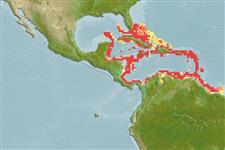>
Eupercaria/misc (Various families in series Eupercaria) >
Lutjanidae (Snappers) > Etelinae
Etymology: Pristipomoides: Greek, pristis = saw + Greek, poma, -atos = cover, operculum + Greek, oides = similar to (Ref. 45335).
More on authors: Müller & Troschel.
Environment: milieu / climate zone / depth range / distribution range
Ecología
marino bentopelágico; rango de profundidad 110 - 550 m (Ref. 55). Deep-water; 27°N - 5°N, 89°W - 53°W (Ref. 55)
Western Central Atlantic: Straits of Florida, Bahamas, Greater Antilles and the Caribbean coast of Nicaragua and Panama.
Length at first maturity / Tamaño / Peso / Age
Maturity: Lm 17.0, range 18 - ? cm
Max length : 50.0 cm TL macho / no sexado; (Ref. 55); common length : 30.0 cm TL macho / no sexado; (Ref. 55)
Espinas dorsales (total): 10; Radios blandos dorsales (total): 11; Espinas anales 3; Radios blandos anales: 8. Interorbital space flat. Eye large. Snout short and blunt. Pectoral fins long reaching level of anus. Scale rows on back parallel to lateral line. Back and upper sides pink with a silvery sheen, grading to silvery ventrally; the fins are translucent to pink.
Adults are most commonly found in deeper waters of the shelf near the edge of the continental slope. They feed on small fishes and larger planktonic animals. Marketed fresh.
Life cycle and mating behavior
Madurez | Reproducción | Puesta | Huevos | Fecundidad | Larva
Allen, G.R., 1985. FAO Species Catalogue. Vol. 6. Snappers of the world. An annotated and illustrated catalogue of lutjanid species known to date. FAO Fish. Synop. 125(6):208 p. Rome: FAO. (Ref. 55)
IUCN Red List Status (Ref. 130435)
Threat to humans
Harmless
Human uses
Pesquerías: escaso valor comercial
Más información
ReferenciasAcuiculturaPerfil de acuiculturaRazasGenéticaElectrophoresesheritabilidadEnfermedadesProcesamientoNutrientsMass conversion
ColaboradoresImágenesStamps, Coins Misc.SonidosCiguateraVelocidadTipo de nataciónSuperficie branquialOtolitosCerebrosVisión
Herramientas
Special reports
Download XML
Fuentes de Internet
Estimates based on models
Preferred temperature (Ref.
123201): 13.6 - 22.3, mean 18.4 °C (based on 45 cells).
Phylogenetic diversity index (Ref.
82804): PD
50 = 0.5005 [Uniqueness, from 0.5 = low to 2.0 = high].
Bayesian length-weight: a=0.01660 (0.00874 - 0.03150), b=2.96 (2.80 - 3.12), in cm total length, based on LWR estimates for this species & Genus-body shape (Ref.
93245).
Nivel trófico (Ref.
69278): 3.9 ±0.56 se; based on food items.
Resiliencia (Ref.
120179): Medio, población duplicada en un tiempo mínimo de 1.4-4.4 años (Preliminary K or Fecundity.).
Fishing Vulnerability (Ref.
59153): Moderate vulnerability (40 of 100).
Nutrients (Ref.
124155): Calcium = 17.4 [7.5, 44.1] mg/100g; Iron = 0.372 [0.162, 0.791] mg/100g; Protein = 17.1 [15.2, 18.9] %; Omega3 = 0.388 [0.170, 0.771] g/100g; Selenium = 18.4 [7.9, 40.4] μg/100g; VitaminA = 24.3 [5.3, 120.4] μg/100g; Zinc = 0.373 [0.242, 0.577] mg/100g (wet weight);
